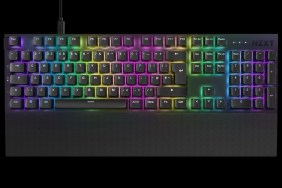I will make the high places low, and the low places high.
Submitted for your consideration, a vision of America that could barely have been imagined in the triumphant days following the end of the Cold War: The midsection of the country is a flooded environmental ruin, thrashed by Mother Climate Change; long-simmering debates on frightening, controversial new areas of research finally boiling to the sociopolitical surface, blaring dire tidings on every news channel, radio frequency, and net forum; the square-jawed old-guarders in the Eastern states squaring off with the separatist Left-Coast wing-nuts ideologically HQ’d in (New) San Francisco; and radical new technologies emerging on that oldest of proving-grounds—the battlefield.
But enough about the present. Let’s look forward to America 2161, as portrayed in LucasArts’s terrain-deforming action game, Fracture.
[image1]The folks at Day 1 Studios start off on a good enough note, with an admirably straight-faced, decent-production-value setup that posits a no-longer-quite-united States. Efforts to literally shore up America’s coastal boarders against the flooding ravages of global warming have been successful, but the middle of the country has essentially become one big environmental annex of the Mississippi, creating a figurative and literal rift in the nation. The separatist ‘Pacificans’ of the West Coast believe that genetic manipulation is the key to mankind’s prosperity—and the Atlantic states call it a crime against humanity. Players take the role of a super-suited Atlantic super soldier named Jet, sent in with the first assault team to take down a renegade Pacifican general. Let the next great American civil war begin—with actual earth-shaking results.
A decided departure for LucasArts, Fracture is a third-person action/combat game whose ‘hook’ is on-the-fly terrain deformation. Fire the Entrencher weapon at the exposed earth in front of you and "Bloop!", a mini-mountain suddenly lurches up out of the ground, providing a ramp of elevated terrain, a raised fire-platform, and/or a big, handy lump of temporary cover. Fire it another way and "Schlorrp!", you’ve created a sudden concavity for use in hiding, tunneling under certain mad-made obstructions, or un-creating the unnatural mound of cover recently made by you or another combatant.
There are other, crazier weapons too, like the one that launches a sort of subterranean torpedo that burrows under the ground in a straight line until it hits something and detonates, like Bugs Bunny failing to make that left turn at Albequerque—only this time with retardo/jihadist results.
My favorite weapon of the lot is a sort of watered-down black hole bomb that detonates, indiscriminately sucks anything nearby into a temporary vortex, swirls it around a bit, blows it to pieces, and spits it back out. There is also an assortment of traditional assault weapons, sniper rifles, and other conventional implements of destruction, too—but the focus of the game is on the terrain-deforming toys, and how they literally shape the battlefield.
I’ve already heard some gamers and critics alike make jokes about how the terrain-shaping technology as presented makes no sense, or why it can’t logically also-do-this or be-used-for-that, or why it doesn’t work on man-made structures, or why, for that matter, the tech can’t be used on a grander scale. It’s good for a few thin laughs, but these folks are missing the point—and anyway, who’s to say? Maybe the terrain-deforming tech has an exponential energy ramp-up. Maybe the effect is inherently local—either way, the shit only works on small patches of dirt, okay?
[image2](It also doesn’t/shouldn’t matter if some visual aspects of the game remind you of Gears of War, or some other extant, high-profile title. What, this is suddenly supposed to be a bad thing? Sheesh, get over it, Poindexters – the proof is in the gameplay.)
Fracture is broken up into three areas. The raw number might not sound impressive, but the size of the said ‘levels’ is—they’re huge, coming only at the very reasonable price of a slightly long initial load time.
The good news is that Fracture’s prime gameplay hook is substantial. Yes, there are some bits where it’s rib-pokingly obvious where you’re supposed to use the Entrencher (although to be fair, the hand-holding, glaringly-guiding tutorial aspects soon fade away, leaving players to their own tactical judgment), but the battlefields become sprawling enough to give players a sense of freedom.
Further, you can do some pretty interesting things with the terrain deformation, such as unearthing buried access tunnels, conjuring sudden, lurching columns of magmic rock out of the ground (to tilt walkways suspended above them into handy access ramps), or launch any unlucky, entrenched enemies thereupon into the air, or even crush opponents and certain defensive structures against low-clearance ceilings and energy barriers. And how about what is essentially a mini-game of raising/lowering the ground to reroute energy beams? Also, when your defenses are just about down to zero, the precious seconds that a newly-created lump of sudden earthy cover can buy you might be just enough to let your shield meter fill up again.
Another obvious but subtle touch is that you’ll lose or gain ground-speed running up or down the side of slopes. Plus, it’s just damned impressive coding, to see the entire battlefield warping and re-warping in a constant, shifting battle and to know that, by God, you’re doing it… at least, until somebody else starts undoing it a few seconds later.
[image3]The bad news is, much of the arguably-cool, showoff terrain-deforming seems so pat, and so halfway-there. Sure it’s neat to blast up a mound of earth to gain enough height to hop the enemy’s ramparts, but your options to attain new terrain heights (or depths) at will suddenly maxes (or bottoms) out for no real reason. Your enemies can be numerous and relentless, but that’s not the same as actually smart. It’s possible to do substantial mischief to your enemies from stand-off range before they get around to doing something about it, which is kind of depressing. There’s a sense of repetition that sets in fairly early in the single-player campaign.
Luckily, the online multiplayer—which performs admirably, even with a full 12-player roster—makes up for a lot of this, offering eight maps and game types. The old standbys are here (deathmatch, CTF, King of the Hill), joined by the Entrencher-heavy Excavation mode, which is exactly what it sounds like—a frantic multiplayer everybody-screw-with-the-terrain-at-once fest. If you thought it was even mildly amusing to see A.I. opponents reacting on the fly to your impromptu landscaping chops (and flying into the air as you blast a new mound of earth into existence under their feet, or comedically Three-Stooging together when you crank off a highly-gravitic Lodestone round into their midst), just wait until you get an eyeful of what you can do to live opponents. Hill-arity ensues—some of it even intentional.
If you’re the type who typically sits around playing video games as a solo endeavor, expect about eight or ten hours of arguably novel gameplay… and not a lot more. If you’re willing and able to drag friends into the online hostilities that are Fracture, you’ll get considerably more reward out of running up that hill.
-
True, on-the-fly terrain modding
-
. . .that you will want more of quickly.
-
Good presentation
-
Unique gameplay hook, even in solo play
-
. . .for a while at least.
-
Interesting game world
-
Multiplay gives the game decent replay legs
-
Repetitive
-
Dumb AI











